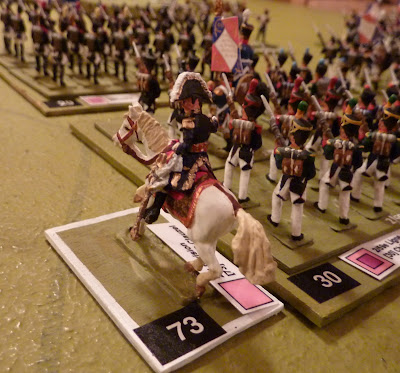The place is crawling with them
Clauzel bringing his boys forward (Art Miniaturen)
French tirailleurs (Falcata & Art Miniaturen)
Morschauser or what?
Our battle was deliberately a big one - towards the upper end of what I think the normal CCN rules will handle. I won't attempt to dignify the game with any kind of report, but a few things and thoughts cropped up which I thought were worth noting.
(1) The action had 30-odd French units (mostly infantry) attacking a similar force of 20-odd Anglo-Portuguese - Bertrand Clauzel, with his own and Maucune's divisions of the Armée de Portugal and some cavalry support, attacking Picton's Allied 3rd Division, again with a little cavalry added. This is a fair old table-load, and again I am struck by the fact that lots of units lined up on a gridded table always looks like Morschauser.
(2) Mostly because I would normally avoid the situation, we placed a fordable river across half the middle ground to see what happens. Man, what a pain. Trying to shift a largish infantry force to stage a proper attack needs some very favourable Command cards at the best of times, and the additional delay caused by the stream makes it awful slow going. The French attack across the stream never got any momentum at all.
(3) Light infantry ducking in and out of woods are handy chaps, and they can fight as soon as they get in there, unlike the line, who have to spend a turn organising before they can carry out any combat when entering a wood.
(4) At one stage, I wasted a serious lot of time trying to defeat a single Portuguese battalion in square - I had two dragoon units nagging away at them, and it was pretty much a stalemate. Some horse artillery would have been a real boon.
(5) The amazing Flying Foot Artillery - at one point, Nick played the dreaded Grande Manoeuvre card, which allows you to move a bunch of units a long way in a hurry, and he took the mad step of advancing a battery of foot artillery onto a bridge over the stream. I wouldn't have done that, but it has to be said that they blew away allcomers for the rest of the battle, and were still there at the end. The point is duly noted.
(6) The main lesson of the session was probably that this size of a battle results in large clusters of units trying to get into action. Unless you are very lucky with the cards, or spend a long time collecting a good hand, the attacker can spend a long, frustrating while trying to trickle everyone into position by twos and threes. Defending becomes a much easier choice. An option, short of switching to my Grand Tactical variant (which would produce a very small game in this case), is maybe to inflate the numbers of units allowed to be ordered by the cards - double would be interesting.
(7) It was still very good fun. Nick enjoyed the CD of Napoleonic marches in the background, which the Royal Society for the Prevention of Cruelty to Children may be surprised to learn, and we finished comfortably in a little over 2 hours, which is remarkable considering the size of the action and the need to explain everything (no - it was me doing the explaining...).
We have to go and fill the bird-feeders now, and then we'll tidy up the battle, and Nick wants to try another one. Good so far.




Sounds like a blast! Your description almost makes me want to plow back into 15mm Napoleonics one day. In any case, I hope my own son might join me, the way yours has joined you, at the wargaming table in another 7-8 years (he's just two at the moment. . . a little young).
ReplyDeleteBest Regards,
Stokes
Sounds like you both had a great game! Loved the quip about your son moving over the bridge with his artillery and smashing all comers! Nice One MSFoy jnr!!!
ReplyDeleteAnd none the worse for looking Morschauseresque. I like the look of the under scale buildings. To me it makes it look more battle-ish. (vs skirmish-ish).
ReplyDeleteIt is so good to have something that works, reliably. But anything wargaming that leads a young lad to want more more would have been good anyway.
-Ross
Stokes - 2 is a little young, as you say. On the other hand, my ancient friend De Vries claimed that he recruited his younger brother to join in his wargames as soon as he was old enough not to chew the soldiers. It also has to be said that his brother gave up on the hobby as soon as he was old enough to run away and hide - cautionary tale!
ReplyDeleteRay - yes, very entertaining - also educational, like playing chess against a novice (and I've been a novice for 50 years!).
Ross - I'm all for my wargames looking like someone else's - that's what passes for credibility in this hobby! The small buildings seem natural now, and are very convenient, but it took months of worrying about it before I made the switch - I was concerned it would look silly (i.e. not like Charles Grant). Now, of course, I know that all wargames look silly to some extent, and I don't care!
Thank you, gentlemen - Tony
I delighted to hear that Foy the younger is gracing the field of Mars.
ReplyDeleteI've played Command & Colours games from everyone from regular gamers to college professors to professional soldiers to young offenders. It's a very robust system.